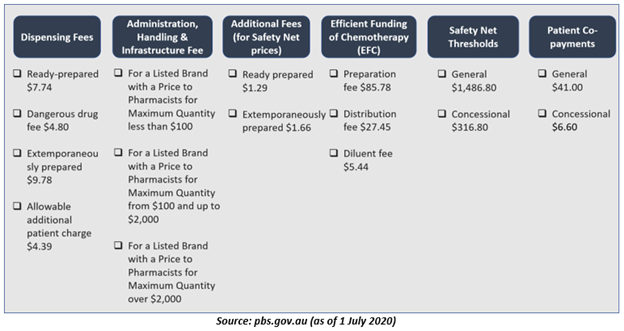What is the Pharmaceutical Benefits Scheme?
The Pharmaceutical Benefits Scheme, or PBS, is designed to offer safe and affordable medicines to all people across Australia. Under the scheme, the government subsidizes the expense of drugs for a range of diseases. The scheme is a part of the National Medicine Policy by the Australian government.
As the cost of some prescription medicines is extremely high, PBS can help lower these costs and make them more affordable. The scheme was launched in 1948 as a restricted scheme, with free medicines for retirees. PBS comprised of nearly 139 life-saving & disease-preventing treatments to be offered free of cost to others in the community. Most of the PBS-listed medications are dispensed by pharmacists and used by patients at home.
Pharmaceutical Benefits Scheme comprises-
- List of all subsidized medicines from A-Z.
- How to use medicines.
- Information related to consumers.
- Cost of medicine (Depending on whether an individual owns a concession card).
PBS is distinct to the Medicare Benefits Schedule, which includes a list of health care facilities that can be claimed under Medicare, a universal health care insurance scheme across Australia.
Who is qualified for PBS?
All residents of Australia possessing a Medicare card are eligible for subsidized medicines under the Pharmaceutical Benefits Scheme. Overseas visitors from nations that have a Reciprocal Health Care Agreement with Australia are also qualified for the scheme. This implies to people from Belgium, Finland, Italy, Malta, the Netherlands, New Zealand, Norway, the Republic of Ireland, Slovenia, Sweden, and the UK.
PBS medicines are available for:
- All citizens of Australia & concession cardholders who have a current Medicare card.
- Visitors from overseas nations with which Australia is having a Reciprocal Health Care Agreement (RHCA).
- Veterans, war widows and widowers, including dependents who are qualified under the RPBS (Repatriation Pharmaceutical Benefits Scheme).
How can an individual get PBS medicines?
To collect PBS medicines, a person needs to show Medicare card while filling the prescription. There will not be any discount for over the counter (OTC) medicines.
If a person has a concession or a health care card, he or she may get PBS medicines at a further discount. The person needs to show Medicare card and any one of the following-

What is the cost of medicine on PBS?
The new drug products cost, as well as review of prices for existing products, is carried out by the PBPA (Pharmaceutical Benefits Pricing Authority).
Under the Pharmaceutical Benefits Scheme, the cost is categorized based on the type of drug or medicine. The image below represents the cost for several medications-

What is the PBAC?
The PBAC or Pharmaceutical Benefits Advisory Committee is an independent expert organization established under the National Health Act 1953. The committee makes suggestions & advice the Minister about which drugs or medicinal preparations should be subsidized on the PBS.
The PBAC deems the medical as well as cost-effectiveness of a proposed benefit compared to other alternative therapies. The committee suggests maximum quantities, repeats as well as may also recommend restrictions for medicines.
When recommending listings, the advisory committee offers advice to the PBPA (Pharmaceutical Benefits Pricing Authority) regarding the comparison of alternatives with the cost-effectiveness of the medicines. The committee has three cycles in a year, each lasting almost 17 weeks.
The PBAC is not a permanent unit in the Department of Health and comprises of medical specialists who meet many times in a year.
How are the medicines listed on the PBS?
Before a drug can be added on the PBS list, it must be approved for use in Australia by the Therapeutic Goods Administration (TGA). The drug sponsor, generally a pharmaceutical company, applies to the TGA to have the drug registered in the ARTG (Australian Register of Therapeutic Goods) so that the drug can be marketed in Australia.
The sponsor must give proof, for instance, clinical trials information, that the drug meets all the required standards of safety, quality and efficacy for the intended use.
In PBS, medicines are listed by drug substances, forms, and strength & brand names. However, it is difficult to provide a total figure for the number of medicines listed on the PBS.
The Therapeutic Goods Administration (TGA) categorizes medicines in a scheduling system that determines where one can get medicines-
- Unscheduled- These drugs are not classified, and a person can purchase them without any restriction (for example- at a supermarket)
- Schedule 2 (S2): These medications can be purchased at a pharmacy.
- Schedule 3 (S3): These medications can only purchase from a pharmacy, where a pharmacist must personally give the medicine and an opportunity to seek advice on the medicine.
- Schedule 4 (S4): These medications can only purchase with a prescription; this includes most items on PBS.
- Schedule 8 (S8): Schedule 8 medicines are classified as drugs of addiction or dependence.
Schedule S2 & S3 medicines are sometimes called OTC (over-the-counter) medicines. Schedule S8 medications are listed on the Pharmaceutical Benefits Scheme have some restrictions which are different in some States and Territories.
What is a non-PBS medicine?
If a drug has been approved by the TGA for sale but the government elects not to subsidize a medicine under the PBS, the drug is considered as a non-PBS drug or private prescription.
The government might take this action because-
- An alternative drug for the same indication currently listed on the PBS and is subsidized.
- The drug is costly, and in the opinion of the government is unsubstantiated.
- The medicine does not work in a better way, or as well as an already existing medicine on the PBS, for that particular indication.
 Please wait processing your request...
Please wait processing your request...